Assessment
Assessment: There are 3 main stages of assessment
- Check the scene
- Check the victim
- Check again
Check the Scene:
- Check the scene for safety before entering. If the scene isn‘t safe, do not enter and call 911.
- Try to find the number of victims and their general condition.
- Check resources, for instance, bystanders or an AED or a first aid kit.
Check the victim:
When you go near the victim, first-of-all check for and treat life-threatening conditions, in order of importance:
- Severe Bleeding
- Inactivity
- Breathing Difficulty

Assessing a Responsive Victim:
1) Check for severe bleeding:
Quickly check the body for severe bleeding. Immediately try to control severe bleeding.
2) Check for victim‟s response:
If a victim seems inactive, tap his shoulder and shout, "Are you okay?" A responsive victim may talk back, move or blink.
3) Check for Breathing:
Look for breathing difficulty signs. Listen for noisy breathing. Is the victim able to speak?
4) Check for injury from head-to-toe:
Check for apparent signs, for instance, wounds, bruising, twisted limbs or burns.
Shock
Shock: Shock is a life-threatening condition that develops when the organs of the body are not getting enough oxygen and blood. This can permanently damage internal organs and even result in death. The objectives of first aid care are to treat any apparent cause of shock, maintain a normal body temperature, and immediately get emergency medical help.
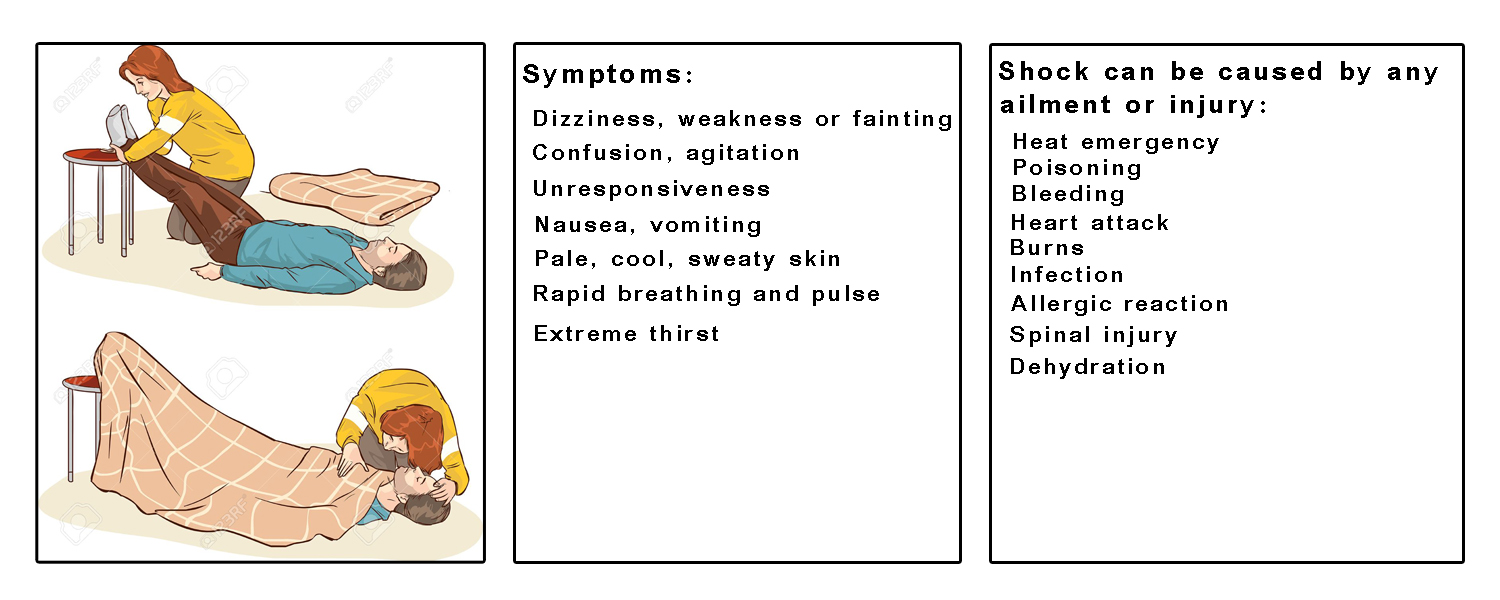
Heart Attack
Heart Attack: Coronary artery ailment develops when cholesterol and fat, attach to the walls of the coronary arteries, causing these to narrow. A heart attack occurs when a clot blocks a narrowed coronary artery, depriving the heart muscle of oxygen. The heart attack victim feels uneasiness as the heart muscle is dying. The symptoms of a heart attack typically happen unexpectedly. These might come-and-go and occur in any combination.
Avoid delay in calling 911:
Heart attack is the main cause of SCA (sudden cardiac arrest). Quick detection and response to early symptoms of heart attack is very important. Clot-busting medication, which is provided in the hospital, is most effective during the early hours of a heart attack. The sooner a heart attack victim gets medical care, the less damage to the heart and the improved the chance of survival.

Stroke
A stroke is an injury to the brain caused by a disruption of blood flow to the brain cells. When a blood vessel becomes blocked or bursts, oxygen-rich blood is unable to reach a portion of the brain and brain cells start to die. A stroke is a life-threatening condition that requires you to identify the symbols and act fast.
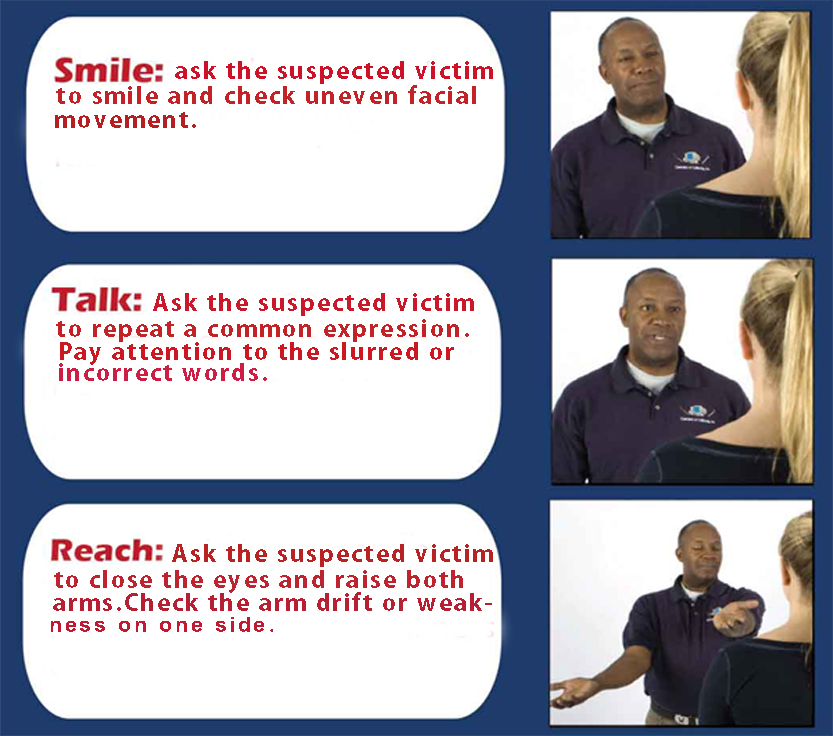
Stroke Assessment:
S-T-R: Use these three initial letters of the word stroke to quickly check for the common stroke symptoms.
 Smile: Ask the suspected victim to smile and check uneven facial movement.
Smile: Ask the suspected victim to smile and check uneven facial movement.
 Talk:Ask the suspected victim to repeat a common expression. Pay attention to the slurred or incorrect words.
Talk:Ask the suspected victim to repeat a common expression. Pay attention to the slurred or incorrect words.
 Reach: Ask the suspected victim to close the eyes and raise both arms. Check the arm drift or weakness on one side.
Reach: Ask the suspected victim to close the eyes and raise both arms. Check the arm drift or weakness on one side.
Call 911 instantly when: There is a sudden and unexpected onset of any stroke symptoms. Do not delay and expect the symptoms to go away, or transport the victim to the hospital yourself. Early detection and fast treatment in the hospital with clot-busting medications are very important for the improved results and survive the stroke.
Seizures
A seizure is an abnormal electrical discharge in the brain that causes loss of awareness and an unexpected change in behavior or sensation. Epilepsy is the most common cause of the seizure. Other causes include stroke, head injury, poisoning, drug overdose, heatstroke, low blood sugar, cardiac arrest or infection.
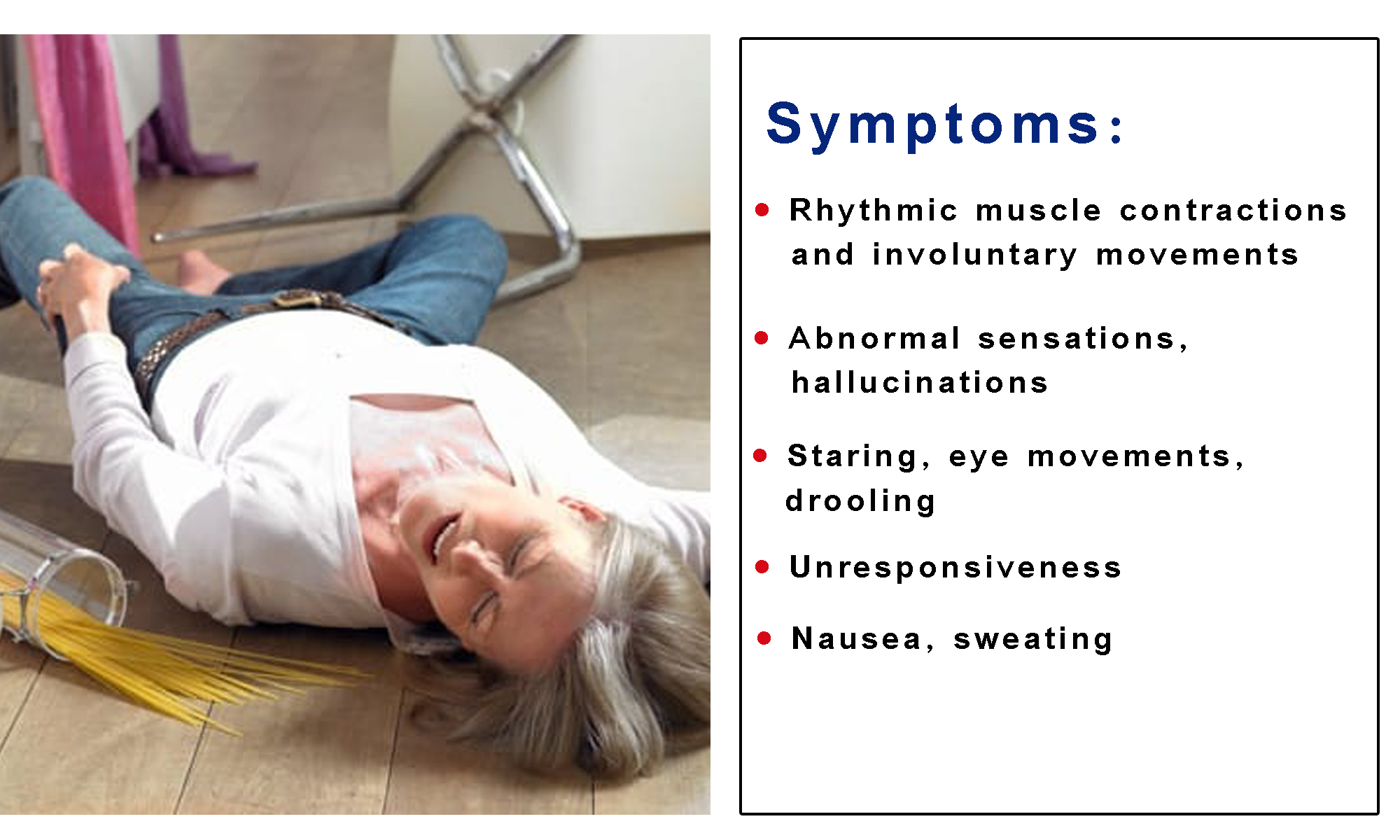
Help:
- Help the victim lie down on the ground.
- Loosen tight clothing.
- Observe breathing and response.
- Call 911 if the victim shows symptoms of sudden illness or does not respond.
Call 911 if:
- Not breathing and inactive, provide CPR.
- Breathing and inactive, turn him on his side to maintain the airway open.
- First time seizure or multiple seizures.
- Possible spine or head injury, support the neck and head together.
- Seizure lasts longer than 5 minutes.
- The victim is pregnant or diabetic.
- Injury-related, or occurred in the water.
Diabetic Emergencies
Diabetes is an ailment that affects the ability of a person to process sugar. Too little or too much sugar in the blood can lead to severe health problems. It‘s a major cause of stroke and heart disease, and affects almost 10% of Americans of all ages. People who know they have diabetes can usually control it with regular exercise, diet and medication. When the blood sugar level of a diabetic person is too low, it can rapidly develop into an emergency, and even turn life-threatening.

Sudden Symptoms:
- A headache or dizziness - Weakness
- Confusion, irritability - Double vision
- Tremor or seizures - Unresponsiveness
- Pale, cool, sweaty skin - Hunger or thirst
- Rapid breathing and pulse
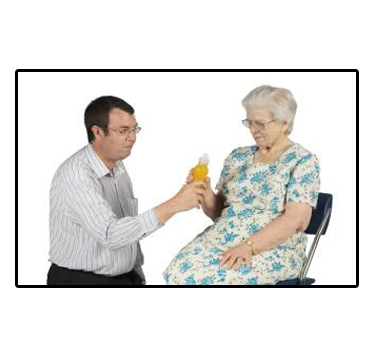
Help:
- Provide fast-acting sugar if the person is able to sit up properly and swallow glucose tablets, sugar dissolved in water, regular soda, orange juice, whole milk, soft chewable candy etc.
- Call 911 if there is no improvement within 15 minutes after giving sugar.
Wounds And Bleeding
An open wound can be minor, requiring basic wound care, or serious, resulting in severe bleeding that can be life-threatening. Control of severe bleeding by a rescuer is a critical first aid treatment that can truly save a life. A person bleeding heavily can die of blood loss within just a few minutes.
 Laceration: It‘s a cut in the skin. A deep laceration may cut a large blood vessel and bleed heavily.M
Laceration: It‘s a cut in the skin. A deep laceration may cut a large blood vessel and bleed heavily.M
 Avulsion: A piece of skin or other tissue completely or partially torn from the body. If possible, replace torn skin, then bandage as a laceration.
Avulsion: A piece of skin or other tissue completely or partially torn from the body. If possible, replace torn skin, then bandage as a laceration.
 Abrasion is painful scraping away of skin. An abrasion often has dirt and debris embedded into it.
Abrasion is painful scraping away of skin. An abrasion often has dirt and debris embedded into it.
 Puncture: It‘s usually deep with minimal bleeding. A puncture has the greatest chance of infection.
Puncture: It‘s usually deep with minimal bleeding. A puncture has the greatest chance of infection.
Minor Wound Care:
Most minor wounds will stop bleeding after a few minutes of direct pressure. Focus on cleaning and bandaging the wound to reduce pain and prevent infection.
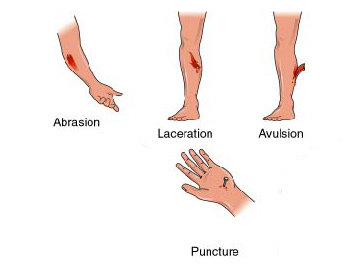
Injuries
Traumatic Injuries
A traumatic injury is caused by a physical force such as a car accident, fall, or gunshot. Trauma is a leading cause of death. Get fast emergency medical help, and check for shock and internal bleeding.
Gunshot Wound:
- Check the scene for safety before you enter.
- Call 911 for Law enforcement.
- Abide by Severe Bleeding Care guidelines.
- Scan for entrance and exit wounds. As compared to entrance wounds, exit wounds may be bigger and bleed more.
- The victim may have serious damage to internal organs, bones and major blood vessels. Avoid moving the victim except to give required care such as severe bleeding control, or CPR, or for safety.
Impaled Object: Foreign object penetration
- Avoid touching or removing the object, unless it is blocking the airway.
- Use a bulky dressing and tape to stabilize it in place.
Amputation: Loss of body part
- Apply firm direct pressure to control the bleeding. Use a tourniquet if you can‘t control bleeding with direct pressure.
- Use dry sterile gauze to wrap the amputated body part and seal it in plastic bag.
- Place the plastic bag inside a second bag with ice. Don‘t let the amputated part freeze or come in direct contact with water or ice.
Joint And Muscle Bone Injuries
A fracture is a break in a bone produced by excessive strain or force. It can be caused by a blow, a fall, a twisting motion, or sometimes from no apparent cause. Sometimes the skin is broken over the fracture site. A dislocation is a separation of bones joined at a joint, usually caused by a fall or hard blow.
Symptoms:
- Bruising, swelling
- Pain and tenderness
- Open wound or exposed bone ends
- A 'SNAP‘ heard at the time of injury
- Deformity
- Crackling sound or grating felt with movement
- Unable to move injured part
- Numb, cold to touch
While waiting for the emergency responders:
Wrap an ice pack in a moist cloth and apply for 15 to 20 minutes.Check for internal bleeding and signs of shock.Observe temperature and sensation further than the injury spot.Splint the injury only if medical rescuers are late, or if you drive the victim yourself from a remote location or for a minor injury.
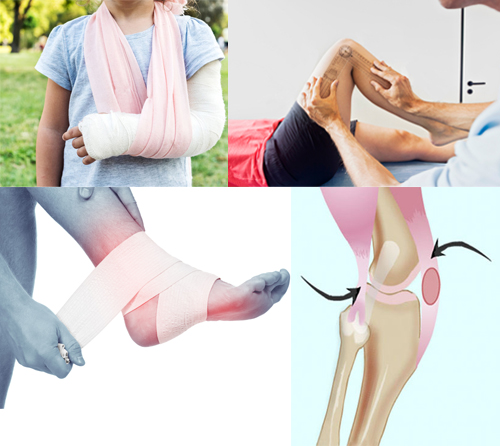
Applying a Splint:
A splint is used to immobilize dislocations, fractures, and severe sprains. Splinting reduces the movement of injured muscles and bones, and allows the person to be transported with less pain and risk of further injury. A splint immobilizes the areas above and below the injury spot.
Head-To-Toe Injuries
A head, neck or spine injury can be very serious, and possibly even life-threatening. Suspect a head, neck or spine injury with:
Head Injuries:
An external head injury is visible, with bleeding from the scalp, or swelling and indentations in the skull.
Traumatic brain injury is damage to the brain itself, despite the bony skull protecting it. A concussion is a bruise to the brain, and is caused by a violent jolt or blow to the head. If you suspect a concussion, have the person evaluated by a healthcare professional before resuming activity.
Tooth and Mouth Injuries:
Injuries to the teeth, tongue or mouth can be a concern due to the risk of inhaling or swallowing blood or pieces of a broken tooth. The objective of first aid is to control bleeding and protect the airway.
Knocked-out permanent tooth:
If an adult tooth is knocked out, the sooner it is reinserted, the better will be the outcome. Don‘t let a knocked-out tooth to dry out.
Eye Injuries
Wrap an ice pack in a damp cloth and apply to reduce swelling and pain. Avoid applying pressure to the eye. Opt for medical care for a black eye or changes in vision.
If there is a cut only on the eyelid and not the eye, use gauze pad to apply gentle pressure and call 911.
Flush the eye straight away. Tilt the head so the affected eye is lower than the unaffected eye and flush gently with running water for at least 20 minutes. Get medical care. Call 911 for a caustic chemical and resume flushing the eye until emergency responders take over.
Small loose foreign objects, for example, sand or dirt particles are usually removed by tears or blinking. If debris remains in the eye, gently flush it with lukewarm water while holding it open.
Jaw Injury:
To immobilize a possible jaw fracture, splint it with a gauze roll. If a gauze roll is unavailable, use a towel, shirt or necktie to secure the jaw. Do not interfere with the airway and do not over tighten the bandage. Stay alert for airway complications. Get professional medical care.
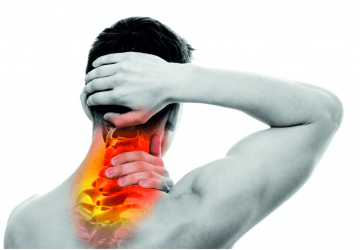
Neck, Back or Spinal Injuries:
The spinal cord is a group of nerve tracts that originates in the brain, runs through the spine, and ends in nerves that go to the various parts of the body. When the spine is injured, the spinal cord may be damaged, possibly resulting in loss of movement, sensation, and even breathing.
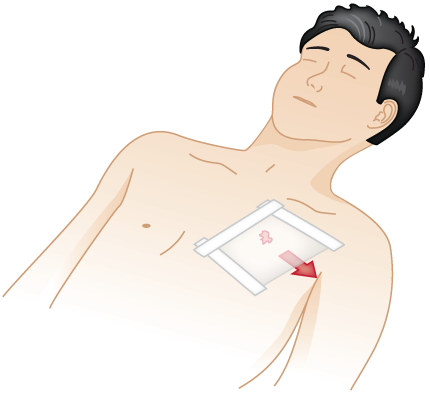
Chest Injuries:
Chest and abdominal injuries are commonly caused by falls, motor vehicle accidents, sports, or penetrating injuries such as gunshot or knife wounds. Consider the mechanism of injury, because internal bleeding from a chest or abdominal injury can be life-threatening.
Burns
Burn seriousness depends on the size and depth of the burn. Burns are classified by the depth of the wound.
1st degree burn (superficial): Red, painful swelling
2nd degree burn (partial): Severe pain, red and splotchy, and swelling may have blisters.
3rd degree burn (severe): Severely damages all layers of the skin, and often muscles, fat and even bones.
Thermal Burns: A thermal burn may result from fire, steam or other exposure to high temperatures. Remove the heat source prior to providing care.
Electrical Burns: An electrical burn may severely damage internal organs. Scene safety is the most important consideration. Before approaching the person, make sure the power has been turned off at the source. Once the scene is safe, treat life-threatening conditions first.
Help:
- Call 911.
- Give CPR or care for shock if required.
- Check for any entrance and exit wounds, and provide care for thermal burns.
Call 911 if:
- Large burn area or multiple burn spots
- Burn injuries to head, neck, hands, feet, genitals, or a major joint
- 3rddegree burn injuries, especially to the elderly, very young, or pregnant
- Airway burn or breathing difficulty. Airway burns cause swelling, which may block the airway.
Chemical Burns: A chemical burn is caused when a caustic chemical gets in the eye or on the skin. It will keep burning until the chemical is removed. A chemical burn to the eye is very dangerous and may cause blindness. Scene safety involves protection from the chemical that burned the victim.
Help:
- Call 911.
- Wear gloves and use a brush to clean-up a dry chemical off the skin.
- Take off contaminated clothing and jewelry.
- Clean the burn with cool water for minimum 20 minutes. Ensure that excess water does not flow over the rescuer or over the unaffected skin.
- If a caustic chemical enters the eye, start flushing the eye with water without delay. Do not stop until emergency rescuers take over the scene.
Choking
Child or Adult Choking:
A serious airway blocking is life-threatening. Identify a choking emergency and act fast. The technique to manage choking is the same for adults and children of age 1 and older. To tell the difference between choking and other emergencies, look for the universal sign of choking: one or both hands at the throat. Suspect choking when someone unexpectedly stops talking.
Mild Chocking:
A person with a mild airway block can cough forcefully or speak. Do not interfere. If the person can speak, he can breathe also. Encourage coughing, and check if the airway blocks severely.
Severe Chocking:
A person with a severe airway block cannot breathe, cough effectively, or speak. He may make a high-pitched sound when inhaling or turn blue around the lips and face.
Infant Choking
Infant Choking: An infant (under 1 year old) won‘t show the universal sign of choking. Remain alert and identify a sudden onset of these symptoms:
- Breathing difficulty or no breathing
- Unable to cry or cough well
- Bluish color skin
- Wheezing or high-pitched sound
- Panic or distressed facial expression
- Bulging or tearing eyes
Mild Chocking: Monitor for choking symptoms. If the infant can cough or cry, do not interfere. Observe for severe airway blockage. Do not leave the infant.
CPR Synopsis
CPR (Cardiopulmonary Resuscitation):
A victim suffering from cardiac arrest is not getting enough oxygen carried to the brain and other vital organs. CPR is a combination of rescue breaths and external chest compressions to deliver oxygen to the brain to keep it alive.
Rescue breaths deliver oxygen to the lungs. Chest compressions squeeze the heart and circulate the blood from the heart to the lungs to get oxygen. The heart refills with blood between each compression. Continuous compressions deliver oxygen all over the body. High-quality chest compressions are the most vital process of CPR.
CPR Barriers:
The risk of getting contaminated while providing rescue breaths is very low. However, many people are not comfortable with providing mouth-to-mouth rescue breaths. CPR barriers can prevent exposure to the blood or body fluids of a victim. A face mask comes with a filtered valve that lets air to enter but prevents the backflow of the fluids. Pick the right size mask to form a seal and provide effective rescue breaths. Apply the mask with the narrow end, on the nose bridge. Firmly press the mask to the victim‘s face and raise the chin to open the airway. A face shield has a built-in fitter or one-way valve. Position the shield with the filter or valve over the victim's mouth. Pinch the nose to provide rescue breaths.
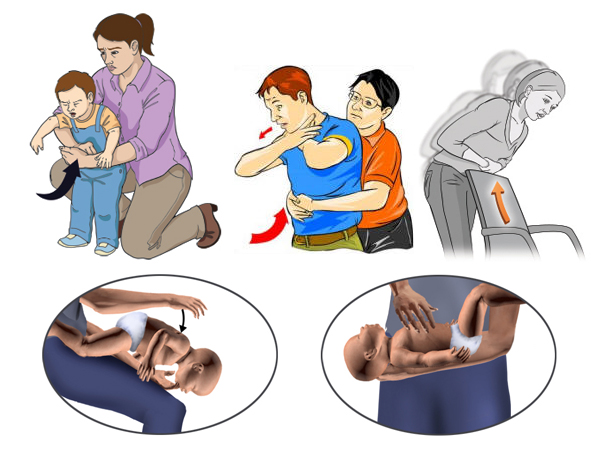
CPR Do‟s And Don‟ts
Hypothermia: The metabolism of the body slows down in a cold environment and reduces the requirement for oxygen. This situation can lengthen the amount of time in which CPR can be successful. Never assume it is too late to start CPR.
Electrical shock: The victim of an electrical shock could abruptly stop breathing or suffer from cardiac arrest. Observe the scene before you enter. Ensure that the power source has been turned off prior to checking the victim.
Child CPR
Child CPR: In children, the cardiac arrest usually occurs due to respiratory arrest and not due to a heart problem. Common causes include poisoning, injury, drowning, choking, and asthma.
Infant CPR
Infant CPR: In infants, cardiac arrest usually occurs due to respiratory arrest and not from a heart ailment. Common reasons include injury, choking, respiratory ailment and SIDS. When CPR is given instantly, a rescuer might be able to restore normal breathing without using an AED.
Infant Age: Less than 1 year old
- Check for response and call 911
- Check for breathing
- Give Chest Compressions
- Open the airway
- Give 2 rescue breaths
- Resume cycles of 30 compressions and 2 rescue breath
